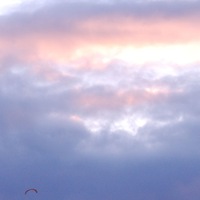Вот примерно таким мне однажды удалось увидеть М13 - шаровое звёздное скопление, состоящее из сотен тысяч звёзд. Находится оно в 25 000 световых лет от нас.
М13 https://ru.wikipedia.org/wiki/M_13_(шаровое_скопление) так называется потому, что у астронома Шарля Мессье, который и обозначил его так, была привычка искать кометы, он был известным ловцом комет, но такие объекты ему постоянно мешали, Мессье путал их с кометами. Правда, само скопление М13 было открыто Эдмундом Галлеем в 1714-м году. А Мессье лишь внёс его в свой каталог. https://ru.wikipedia.org/wiki/Каталог_Мессье
В слабый телескоп они выглядят туманными пятнышками (ни галактики, ни шаровые звёздные скопления толком не видны в маленькие телескопы и представляют собой серые туманные пятна, примерно как на этом фото справа вверху), поэтому он решил описать все такие объекты, начал с М1 - туманности Краба (или Крабовидной туманности), и закончил М103.
Таким образом, появился замечательный каталог объектов глубокого космоса - каталог Мессье. Который содержит 110 (первая версия каталога состояла из 103 объектов, ученики Месье добавили ещё 7) туманностей, галактик, шаровых и рассеянных звёздных скоплений.
Когда Мессье наблюдал за кометами, он не знал, что существуют другие галактики, давно это было, в 18-м веке. Это знание пришло к людям в начале 20 века, в 10-х и 20-х годах прошлого века люди стали постепенно догадываться, что некоторые туманные пятна находятся очень далеко от Земли и не могут быть частью нашей Галактики. Но Месье знал, что существуют звёздные скопления, например, шаровое звёздное скопление М4 (из своего каталога) он описал именно как скопление мелких звёзд.
На фестиваль астрономии "Астрофест" http://www.astrofest.ru иногда привозят огромные телескопы, так было и в тот раз, когда мне удалось увидеть М13. Диаметр телескопа составлял целых 500 мм! Это было похоже на крупинки соли или сахара, на чёрной скатерти неба, или что-то в этом духе. Казалось, я видел и мог сосчитать каждую звезду. Непередаваемо и незабываемо. Советую всем, кто сможет посетить фестиваль, полюбоваться именно М13. Его видно невооружённым глазом, правда, наблюдать нужно из глухой деревни, т.к. звёздная величина скопления +5,8 - это на пределе видимости глазом звёзд. А ещё туда отправили сигнал, ждём ответа через 50 000 лет:). https://ru.wikipedia.org/wiki/Послание_Аресибо
Расстояние до этого скопления оценивается в 25 000 световых лет, примерно как до центра нашей Галактики. Диаметр скопления около 160 световых лет. И представьте, в таком объёме находится несколько сот тысяч звёзд. Напомню, что расстояние до ближайшей к нам звезды оценивается в 4 световых года. Т.е. в этом скоплении плотность звёзд в 100-1000 раз выше, чем в окрестностях Солнечной Системы.
Самое интересное во всём этом то, что до сих пор никто не знает как именно сформировались эти шаровые скопления.
P.S. На врезке - скопление М13 "глазами" телескопа им. Хаббла
М13 https://ru.wikipedia.org/wiki/M_13_(шаровое_скопление) так называется потому, что у астронома Шарля Мессье, который и обозначил его так, была привычка искать кометы, он был известным ловцом комет, но такие объекты ему постоянно мешали, Мессье путал их с кометами. Правда, само скопление М13 было открыто Эдмундом Галлеем в 1714-м году. А Мессье лишь внёс его в свой каталог. https://ru.wikipedia.org/wiki/Каталог_Мессье
В слабый телескоп они выглядят туманными пятнышками (ни галактики, ни шаровые звёздные скопления толком не видны в маленькие телескопы и представляют собой серые туманные пятна, примерно как на этом фото справа вверху), поэтому он решил описать все такие объекты, начал с М1 - туманности Краба (или Крабовидной туманности), и закончил М103.
Таким образом, появился замечательный каталог объектов глубокого космоса - каталог Мессье. Который содержит 110 (первая версия каталога состояла из 103 объектов, ученики Месье добавили ещё 7) туманностей, галактик, шаровых и рассеянных звёздных скоплений.
Когда Мессье наблюдал за кометами, он не знал, что существуют другие галактики, давно это было, в 18-м веке. Это знание пришло к людям в начале 20 века, в 10-х и 20-х годах прошлого века люди стали постепенно догадываться, что некоторые туманные пятна находятся очень далеко от Земли и не могут быть частью нашей Галактики. Но Месье знал, что существуют звёздные скопления, например, шаровое звёздное скопление М4 (из своего каталога) он описал именно как скопление мелких звёзд.
На фестиваль астрономии "Астрофест" http://www.astrofest.ru иногда привозят огромные телескопы, так было и в тот раз, когда мне удалось увидеть М13. Диаметр телескопа составлял целых 500 мм! Это было похоже на крупинки соли или сахара, на чёрной скатерти неба, или что-то в этом духе. Казалось, я видел и мог сосчитать каждую звезду. Непередаваемо и незабываемо. Советую всем, кто сможет посетить фестиваль, полюбоваться именно М13. Его видно невооружённым глазом, правда, наблюдать нужно из глухой деревни, т.к. звёздная величина скопления +5,8 - это на пределе видимости глазом звёзд. А ещё туда отправили сигнал, ждём ответа через 50 000 лет:). https://ru.wikipedia.org/wiki/Послание_Аресибо
Расстояние до этого скопления оценивается в 25 000 световых лет, примерно как до центра нашей Галактики. Диаметр скопления около 160 световых лет. И представьте, в таком объёме находится несколько сот тысяч звёзд. Напомню, что расстояние до ближайшей к нам звезды оценивается в 4 световых года. Т.е. в этом скоплении плотность звёзд в 100-1000 раз выше, чем в окрестностях Солнечной Системы.
Самое интересное во всём этом то, что до сих пор никто не знает как именно сформировались эти шаровые скопления.
P.S. На врезке - скопление М13 "глазами" телескопа им. Хаббла
Something like this I once managed to see M13 - a globular star cluster consisting of hundreds of thousands of stars. It is located 25,000 light years away from us.
M13 https://ru.wikipedia.org/wiki/M_13_ (globular cluster) is so called because the astronomer Charles Messier, who marked it like that, had a habit of searching for comets, he was a famous comet catcher, but such objects constantly interfered with him Messier confused them with comets. True, the M13 cluster itself was discovered by Edmund Halley in 1714. And Messier only made it into his catalog. https://ru.wikipedia.org/wiki/Massier_Catalog
In a weak telescope, they look like misty spots (neither galaxies, nor globular star clusters are clearly visible in small telescopes and are gray haze spots, just like in the photo above right), so he decided to describe all such objects, started with M1 - nebula Crab (or Crab Nebula), and finished M103.
Thus, a remarkable catalog of deep space objects appeared - Messier's catalog. Which contains 110 (the first version of the catalog consisted of 103 objects, Monsieur’s students added 7 more) of nebulae, galaxies, globular and open clusters.
When Messier observed the comets, he did not know that there were other galaxies, it was a long time ago, in the 18th century. This knowledge came to people at the beginning of the 20th century, in the 10s and 20s of the last century, people gradually began to guess that some fog spots are very far from the Earth and cannot be part of our Galaxy. But Monsieur knew that there were star clusters, for example, he described the globular star cluster M4 (from his catalog) as a cluster of small stars.
At the Astrofest astronomy festival http://www.astrofest.ru sometimes huge telescopes are brought in, and that was the time when I managed to see the M13. The diameter of the telescope was as much as 500 mm! It was like grains of salt or sugar, on the black tablecloth of the sky, or something like that. It seemed that I had seen and could count every star. Inexpressible and unforgettable. I advise everyone who can attend the festival to admire the M13. It can be seen with the naked eye, however, you need to watch from a deaf village, because the magnitude of the cluster is +5.8 - this is at the limit of visibility by the eyes of the stars. And they also sent a signal there, waiting for an answer in 50,000 years :). https://ru.wikipedia.org/wiki/Post-Aresibo
The distance to this cluster is estimated at 25,000 light-years, approximately as far as the center of our galaxy. The cluster diameter is about 160 light years. And imagine, in such a volume are several hundred thousand stars. Let me remind you that the distance to the star nearest to us is estimated at 4 light years. Those. in this cluster, the density of stars is 100-1000 times higher than in the vicinity of the Solar System.
The most interesting thing about all this is that so far nobody knows exactly how these globular clusters were formed.
P.S. Inset - cluster M13 "eyes" of the telescope. Hubble
M13 https://ru.wikipedia.org/wiki/M_13_ (globular cluster) is so called because the astronomer Charles Messier, who marked it like that, had a habit of searching for comets, he was a famous comet catcher, but such objects constantly interfered with him Messier confused them with comets. True, the M13 cluster itself was discovered by Edmund Halley in 1714. And Messier only made it into his catalog. https://ru.wikipedia.org/wiki/Massier_Catalog
In a weak telescope, they look like misty spots (neither galaxies, nor globular star clusters are clearly visible in small telescopes and are gray haze spots, just like in the photo above right), so he decided to describe all such objects, started with M1 - nebula Crab (or Crab Nebula), and finished M103.
Thus, a remarkable catalog of deep space objects appeared - Messier's catalog. Which contains 110 (the first version of the catalog consisted of 103 objects, Monsieur’s students added 7 more) of nebulae, galaxies, globular and open clusters.
When Messier observed the comets, he did not know that there were other galaxies, it was a long time ago, in the 18th century. This knowledge came to people at the beginning of the 20th century, in the 10s and 20s of the last century, people gradually began to guess that some fog spots are very far from the Earth and cannot be part of our Galaxy. But Monsieur knew that there were star clusters, for example, he described the globular star cluster M4 (from his catalog) as a cluster of small stars.
At the Astrofest astronomy festival http://www.astrofest.ru sometimes huge telescopes are brought in, and that was the time when I managed to see the M13. The diameter of the telescope was as much as 500 mm! It was like grains of salt or sugar, on the black tablecloth of the sky, or something like that. It seemed that I had seen and could count every star. Inexpressible and unforgettable. I advise everyone who can attend the festival to admire the M13. It can be seen with the naked eye, however, you need to watch from a deaf village, because the magnitude of the cluster is +5.8 - this is at the limit of visibility by the eyes of the stars. And they also sent a signal there, waiting for an answer in 50,000 years :). https://ru.wikipedia.org/wiki/Post-Aresibo
The distance to this cluster is estimated at 25,000 light-years, approximately as far as the center of our galaxy. The cluster diameter is about 160 light years. And imagine, in such a volume are several hundred thousand stars. Let me remind you that the distance to the star nearest to us is estimated at 4 light years. Those. in this cluster, the density of stars is 100-1000 times higher than in the vicinity of the Solar System.
The most interesting thing about all this is that so far nobody knows exactly how these globular clusters were formed.
P.S. Inset - cluster M13 "eyes" of the telescope. Hubble

У записи 11 лайков,
1 репостов,
318 просмотров.
1 репостов,
318 просмотров.
Эту запись оставил(а) на своей стене Игорь Тирский






























